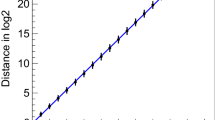Abstract
We further develop our previous proposal to use hyperbolic Anosov C-systems to generate pseudorandom numbers and to use them for efficient Monte Carlo calculations in high energy particle physics. All trajectories of hyperbolic dynamical systems are exponentially unstable, and C-systems therefore have mixing of all orders, a countable Lebesgue spectrum, and a positive Kolmogorov entropy. These exceptional ergodic properties follow from the C-condition introduced by Anosov. This condition defines a rich class of dynamical systems forming an open set in the space of all dynamical systems. An important property of C-systems is that they have a countable set of everywhere dense periodic trajectories and their density increases exponentially with entropy. Of special interest are the C-systems defined on higher-dimensional tori. Such C-systems are excellent candidates for generating pseudorandom numbers that can be used in Monte Carlo calculations. An efficient algorithm was recently constructed that allows generating long C-system trajectories very rapidly. These trajectories have good statistical properties and can be used for calculations in quantum chromodynamics and in high energy particle physics.
Similar content being viewed by others
References
D. V. Anosov, Proc. Steklov Inst. Math., 90, 1–235 (1967).
G. A. Hedlund, Bull. Amer. Math. Soc., 45, 241–246 (1939).
E. Hopf, Math. Ann., 117, 590–608 (1940).
D. V. Anosov and Ya. G. Sinai, Russ. Math. Surveys, 22, 103–167 (1967).
A. N. Kolmogorov, Dokl. Acad. Sci. USSR, 119, 861–865 (1958).
A. N. Kolmogorov, Dokl. Acad. Sci. USSR, 124, 754–755 (1959).
Ya. G. Sinai, Dokl. Acad. Sci. USSR, 124, 768–771 (1959).
N. S. Krylov, Works on the Foundation of Statistical Physics [in Russian], Acad. Sci. USSR, Moscow (1950); English transl., Princeton Univ. Press, Princeton, N. J. (1979).
V. Arnold, Ann. Inst. Fourier (Grenoble), 16, 319–361 (1966).
G. K. Savvidy, Phys. Lett. B, 130, 303–307 (1983).
G. Savvidy, Nucl. Phys. B, 246, 302–304 (1984).
V. G. Gurzadyan and G. K. Savvidy, Astron. Astrophys., 160, 203–210 (1986).
G. W. Gibbons, Class. Q. Grav., 33, 025004 (2015); arXiv:1508.06755v2 [gr-qc] (2015).
G. K. Savvidy and N. G. Ter-Arutyunyan-Savvidy, J. Comput. Phys., 97, 566–572 (1991); “On the Monte Carlo simulation of physical systems,” Preprint EFI-865-16-86-YEREVAN, EFI, Yerevan (1986).
K. G. Savvidy, Comput. Phys. Commun., 196, 161–165 (2015); arXiv:1404.5355v2 [astro-ph.HE] (2014).
MIXMAX Network Meeting, https://indico.cern.ch/event/404547; The ROOT project, http://ph-dep-sft.web.cern.ch/project/root; The GEANT4 project, http://ph-dep-sft.web.cern.ch/project/geant4.
European Union’s Horizon 2020, http://mixmax.hepforge.org; http://www.inp.demokritos.gr/~savvidy/mixmax.php.
V. A. Rokhlin, Izv. Akad. Nauk SSSR Ser. Mat., 28, 867–874 (1964).
I. P. Cornfeld, Y. G. Sinai, and S. V. Fomin, Ergodic Theory [in Russian], Nauka, Moscow (1980); English transl.: I. P. Cornfeld, S. V. Fomin, and Y. G. Sinai (Grundlehren Math. Wiss., Vol. 245), Springer, New York (1982).
V. P. Leonov, Sov. Math. Dokl., 1, 1252–1255 (1960).
I. M. Sobol’, Calculation of the Monte Carlo Method [in Russian], Nauka, Moscow (1973); English transl.: The Monte Carlo Method, Univ. of Chicago Press, Chicago (1974).
S. Smale, Bull. Amer. Math. Soc., 73, 747–817 (1967).
Ya. G. Sinai, Funct. Anal. Appl., 2, 61–82 (1968).
G. A. Margulis, Funct. Anal. Appl., 4, 55–67 (1970).
R. Bowen, Equilibrium States and the Ergodic Theory of Anosov Diffeomorphisms (Lect. Notes Math., Vol. 470), Springer, Berlin (1975).
R. Bowen, Amer. J. Math., 94, 1–30 (1972).
R. Bowen, Trans. Amer. Math. Soc., 154, 377–397 (1971).
V. A. Rokhlin, Izv. Akad. Nauk SSSR Ser. Mat., 13, 329–340 (1949).
V. A. Rokhlin, Theory Probab. Appl., 6, 322–323 (1961).
Ya. G. Sinai, “Probabilistic ideas in ergodic theory,” in: Proc. Intl. Congress of Mathematicians (Stockholm, 15–22 August 1962), Inst. Mittag-Leffler, Djursholm, Sweden (1963), pp. 540–559.
A. L. Gines, Sov. Math. Dokl., 2, 750–752 (1961).
N. C. Metropolis and S. Ulam, J. Amer. Statist. Assoc., 44, 335–341 (1949).
N. C. Metropolis, G. Reitwiesner, and J. von Neumann, Math. Tables and Other Aids to Computation, 4, 109–111 (1950).
J. von Neumann, J. Res. Nat. Bur. Stand. Appl. Math. Ser., 12, 36–38 (1951).
F. James, “Finally, a theory of random number generation,” in: Scattering and Biomedical Engineering: Modeling and Applications (Fifth Intl. Workshop on Mathematical Methods in Scattering Theory and Biomedical Technology, Corfu, Greece, 18–19 October 2001, D. Fotiadis and C. Massalas, eds.), World Scientific, Singapore (2002), pp. 114–121.
V. Demchik, Comput. Phys. Commun., 182, 692–705 (2011); arXiv:1003.1898v1 [hep-lat] (2010).
M. Falcioni, L. Palatella, S. Pigolotti, and A. Vulpiani, Phys. Rev. E, 72, 016220 (2005).
P. L’Ecuyer and R. Simard, ACM Trans. Math. Software, 33, No. 4, 22 (2007).
N. Z. Akopov, G. K. Savvidy, and N. G. Ter-Arutyunyan-Savvidy, J. Comput. Phys., 97, 573–579 (1991); “Matrix generator of pseudorandom numbers,” Preprint EFI-867-18-86-YEREVAN, EFI, Yerevan (1986).
G. G. Athanasiu, E. G. Floratos, and G. K. Savvidy, Internat. J. Mod. Phys. C, 8, 555–565 (1997).
N. Niki, Proc. Inst. Statist. Math., 32, 231–239 (1984).
H. Niederreiter, Math. Japon., 31, 759–774 (1986).
R. Lidl and H. Niederreiter, Finite Fields (Encycl. Math. Its Appl., Vol. 20), Addison-Wesley, Reading, Mass. (1983); “Finite fields, pseudorandom numbers, and quasirandom points,” in: Finite Fields, Coding Theory, and Advances in Communications and Computing (Lect. Notes Pure Appl. Math., Vol. 141, G. L. Mullen and P. J. S. Shiue, eds.), Dekker, New York (1993), pp. 375–394.
V. Arnol’d and A. Avez, Ergodic Problems of Classical Mechanics, New York (1968).
Author information
Authors and Affiliations
Corresponding author
Additional information
This research was supported in part by the European Union’s Horizon 2020 research and innovation program under a Marie Skíodowska-Curie grant (Agreement No. 644121).
Prepared from an English manuscript submitted by the author; for the Russian version, see Teoreticheskaya i Matematicheskaya Fizika, Vol. 188, No. 2, pp. 223–243, August, 2016.
Rights and permissions
About this article
Cite this article
Savvidy, G.K. Anosov C-systems and random number generators. Theor Math Phys 188, 1155–1171 (2016). https://doi.org/10.1134/S004057791608002X
Received:
Published:
Issue Date:
DOI: https://doi.org/10.1134/S004057791608002X



